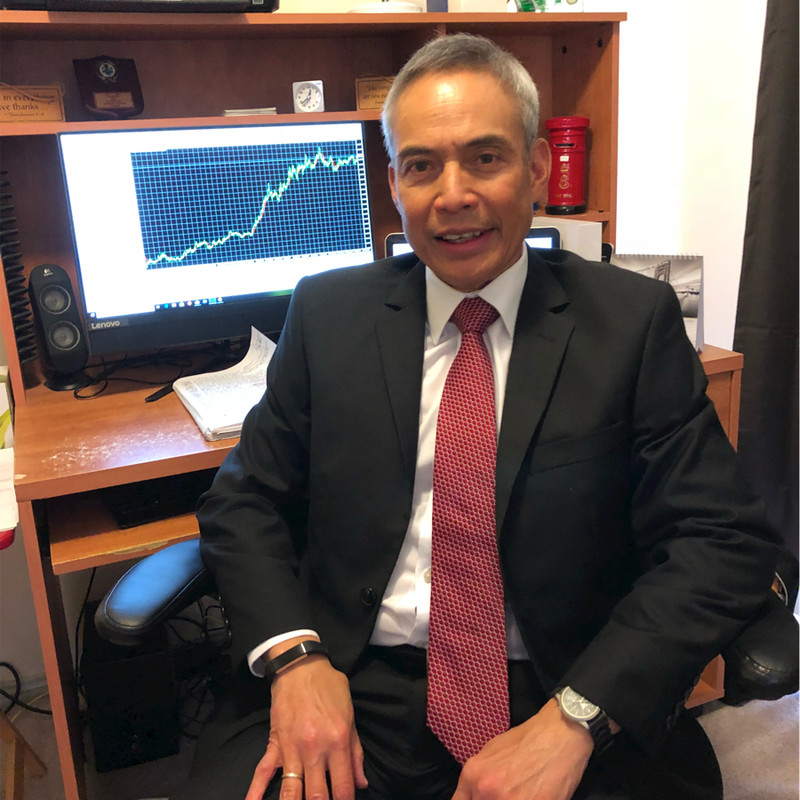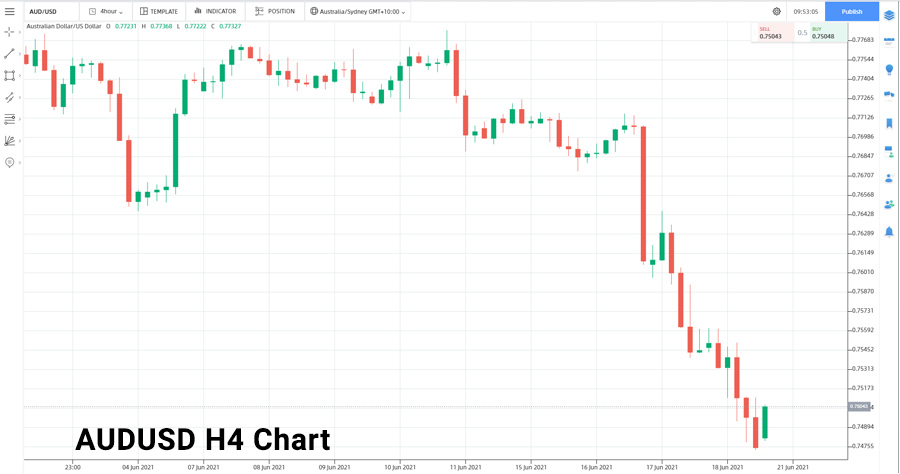Dollar Extends Surge as More Shorts are Unwound; Stocks Slide

- Michael Moran , Senior Currency Strategist at ACY Securities
- 21.06.2021 01:00 pm trading
Risk-Off Sees AUD, GBP Plunge; Yen Up; US Yield Curve Flattens
Summary: The Dollar extended its surge against all its Rivals in choppy trade on Friday, closing at its highest since mid-April. A popular gauge of the Greenback’s value against a basket of 6 major currencies, the Dollar Index (USD/DXY) soared 1.3% higher in the past 2 days to 92.35 (91.25 Thursday). The move as the result of a massive unwind of USD shorts/Currency longs which began after the Federal Reserve shifted its economic projections, anticipating two rate hikes in 2023. A stronger Greenback and risk aversion pushed the Australian Dollar to its lowest finish this year at 0.7480 (0.7548 Friday). The Aussie lost almost 3% in 3 trading days and finished as worst performing major against the Dollar. Sterling slumped 1.1% to 1.3810 from 1.3920 after a massive miss in UK May Retail Sales, down 1.4% against expectations of a 1.6% rise. The Euro slid 0.53% to 1.1860 (1.1902), faring better on robust German Producer Prices and stronger Eurozone Current Account balance. Against the Japanese Yen, the US Dollar eased 0.22% to 110.20 (110.30) on the lower US 10-year bond yield and risk aversion. US stock prices slid anew with the DOW losing 1.5% on Friday to 33,305, and the S&P 500 down 1.4% to 4,165 (4,223). While the US 10-year bond yield fell to 1.44% (from 1.50% Friday), two-year US treasury rates climbed to 0.25% from 0.20%. The often referred-to flattening of the yield curve (higher short-term rates vs lower long-term rates) reflect expectations that higher Fed rates will see slower growth. Other global bond rates were mostly flat or a touch lower. Germany’s 10-year Bund rate was unchanged at -0.20%. Japan’s 10-year JGB yield was last at 0.04% (0.05% Friday) after the Bank of Japan kept its Policy Rate (-0.10%) and monetary policy unchanged, which was widely anticipated.
Data released Friday saw Japan’s National Core CPI (May) climb to 0.1% from April’s -0.1%, beating forecasts at 0.0%. Germany’s May PPI rose 1.5% (m/m) beating expectations of a 0.7% rise and April’s +0.8%). The Eurozone Current Account Surplus (April) rose to +EUR 22.8 billion from the previous +EUR 17.8 billion. UK May Retail Sales fell to -1.4% missing forecasts for a 1.5% rise and a previous +9.2%.
- GBP/USD – Sterling’s slide extended on Friday to a 1.3810 finish (1.3920 Thursday). Weaker-than-forecast UK Retail Sales in May, which fell -1.4% coupled with an overall stronger US Dollar weighed on the British currency. The Bank of England meets on policy this Thursday which could well change the fortunes for the Pound. Sterling closed as second worst performing currency among the majors.
- AUD/USD – slip-sliding away, the Aussie was battered lower, breaking the 0.75 cent support area to 0.7480, its lowest close in 2021. Souring risk sentiment weighed on the Australian Battler, which lost almost 3% in 3 trading days.
- EUR/USD – The shared currency fared better than its peers against the rampaging US Dollar. Massive unwinding of long speculative Euro bets weighed on the EUR/USD pair which finished at 1.1860 (1.1905 Friday). EUR/USD has lost 2.3 % against the Greenback since Thursday.
- USD/JPY – The Dollar lost ground against the Japanese Yen on Friday to 110.28 (110.65) on the market’s risk off stance. While the Greenback’s advance versus the haven sought Yen was more subdued than other Rivals, USD/JPY hit an overnight peak at 110.82 before slipping at the New York close.
On the Lookout: Broad US Dollar strength should extend as we kick off this week in Asia. Market participants will focus on the movement in US bond markets and their effect on yields as well as upcoming economic data releases. The US 10-year bond yield slid a further 6 basis points to 1.44% on Friday. Other global bond yields were either flat or a few basis points lower. This should prevent any further big falls in the Dollar’s Rivals.
Today’s economic calendar is light but picks up mid-week. Australia kicks off with its May Preliminary Retail Sales report (f/c to dip to 0.7% from April’s 1.1% -FX Street). The UK releases its Rightmove House Price Index for June (m/m; May was 1.8%). China’s People’s Bank of China (central bank) has its Interest Rate Decision. China’s 1 Year Prime Rate stands at 3.85% - Finlogix. Germany’s Bundesbank releases its Monthly report. ECB President Christine Lagarde is due to speak at a virtual hearing before the European Parliament and Monetary Affairs Committee. The US releases its Chicago Fed National Activity Index (April’s Index was 0.24 – Finlogix).
The week ahead sees Global (Australia, Japan, Euro area, Eurozone, UK and US) Flash Manufacturing and Services PMI’s released on Wednesday. Thursday sees the Bank of England’s Interest Rate Decision and Monetary Policy Meeting, and US Final Q1 GDP release. On Friday the UK and Germany release their GFK Consumer Confidence reports and the US reports its latest Personal Income, Personal Spending, Core PCE Price Index and the University of Michigan Consumer Sentiment Index (Finlogix).
Trading Perspective: After two days of solid gains, expect the US Dollar to consolidate with Asian traders likely hesitant to take it to new ground. The drop in the US 10-year bond yield to 1.44%, despite higher US 2-year rates and a narrowing of the yield curve will prevent further US Dollar advances. The yield differential between US and global 10-year rates has narrowed and the weak speculative USD shorts will have cut their positions. Which will limit further big falls on the Dollar’s Rivals for now. Today’s economic calendar is light.
- AUD/USD – As this is written, the Aussie has clawed its way back above 0.75 cents in early Asia (0.7502) from Friday’s NY close at 0.7480. On Friday, the Aussie was the worst performing major, closing at the lows for 2021. Immediate resistance on the topside lies at 0.7545 followed by 0.7575 and 0.7600. Immediate support can be found at 0.7475 (overnight low traded was 0.7470). The next support for AUD/USD lies at 0.7450 and 0.7400. Look for consolidation today with a likely range between 0.7480 and 0.7580. Am not getting bearish on the Battler down at these levels just yet.

- GBP/USD – slid a further 1.1% on Friday to 1.3810 at the New York close from its 1.3920 opening. Sterling, already under pressure from the overall stronger Greenback, was pounded lower following the release of weaker-than-expected UK Retail Sales in May. We could see further choppy moves in the British currency ahead and into this Thursday’s BOE meeting. The Bank of England was one of the first central banks to taper asset purchases. Immediate support for Cable lies at 1.3785 (overnight low 1.37844) followed by 1.3750 (strong). Immediate resistance can be found at 1.3850 and 1.3900. Expecting further choppy trade in a likely 1.3790-1.3890 range to start the week.
- EUR/USD – The extent of the drop in the Euro on Friday was less than the other USD rivals despite an overstretched position. Stronger-than-expected German producer prices and a higher Eurozone Current Account Surplus buoyed the shared currency. EUR/USD traded to an overnight low at 1.1847 before rebounding to close at 1.1860. In early Asia, the Euro is currently changing hands at 1.1874 against the Greenback. Immediate resistance can be found at 1.1920 and 1.1970. Immediate support lies at 1.1850 and 1.1810. The 1.1780 support level is strong and should hold for now. Look for a likely trade in the Euro between 1.1790 and 1.1890.
- USD/JPY – The Dollar eased against the haven sought Japanese Yen to finish at 110.20, modestly lower than its Friday start at 110.30. USD/JPY hit an overnight peak at 110.484 before slipping lower in late New York. Immediate resistance lies at 110.50 followed by 110.70. Immediate support can be found at 109.95 (overnight low traded was 109.94). The next support level lies at 109.70 (strong) and 109.40. Look for a likely trading range today between 109.85 and 110.55. Prefer to buy the dip to 109.85, we may still yet see more topside to this currency pair.
Welcome back volatility! “Welcome back, welcome back, welcome back.” Remembering a line from an old 70’s favourite by John Sebastian aptly titled: “Welcome Back.” Have a good trading week ahead all. Happy Monday.



























